
82
IMS-MN-LMDA42C_A.pdf
Glossary
LMD CANopen
Error
: Operating state of the drive caused as a result of a discrepancy between a detected
(computed, measured, or signaled) value or condition and the specified or theoretically correct
value or condition.
Error Class
: Classification of errors into groups. The different error classes allow for specific
responses to faults (e.g., by severity).
G
Ground (Earth) Loop
: A ground (earth) loop is any part of the DC return path (ground) that has
more than one possible path between any two points.
H
Half Step
: This term means that the motor shaft will move a distance of 0.9 degree (400 steps
per shaft revolution) instead of moving 1.8 degree per digital pulse.
Hybrid Motion Technology™ (hMT)
: A motor control technology which bridges the gap
between stepper and servo performance.
Holding Torque
: The maximum torque or force that can be externally applied to a stopped,
energized motor without causing the rotor to rotate continuously. This is also called “static
torque”.
I
I/O
: Inputs/outputs
Index Pulse
: Signal of an encoder to reference the rotor position in the motor. The encoder
returns one index pulse per revolution.
Inertia
: A measure of an object’s resistance to a change in velocity. The larger an object’s
inertia, the greater the torque required to accelerate or decelerate it. Inertia is a function of an
object’s mass and shape. For the most efficient operation, the system-coupling ratio should be
selected so that the reflected inertia of the load is equal to or no greater than 10 times the rotor
inertia of the stepper motor.
Inertia (Reflected)
: Inertia as seen by the stepper motor when driving through a speed change,
reducer, or gear train.
L
Lag
: The amount (in full motor steps) that the rotor lags the stator. Lag conditions are caused
by loading on the motor shaft, as during transient loading or rapid acceleration.
Lead
: The amount (in full motor steps) that the rotor leads the stator. Lead conditions are
caused by an overhauling load, as during periods of rapid deceleration.
Limit Switch
: Switch that signals overtravel of the permissible range of travel.
Load
: Any external resistance (static or dynamic) to motion that is applied to the motor.
Locked Rotor
: When the lag/lead limit is reached, a timer starts a countdown that is
determined by the user. The locked rotor will assert itself by triggering a flag and, depending
on the selected mode, by disabling the output bridge.
Loss of synchronization
: In traditional stepper systems, when the lead/lag relationship of the
rotor and stator reaches two full motor steps, the alignment of the magnetic fields is broken
and the motor will stall in a freewheeling state.





































